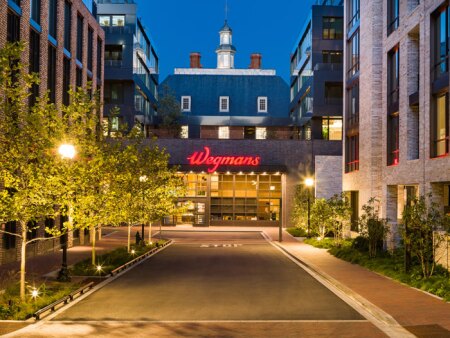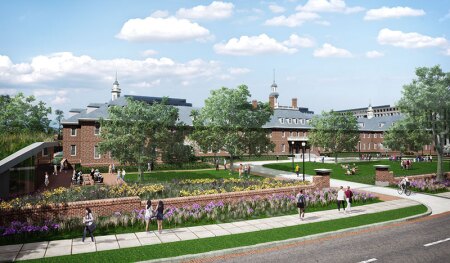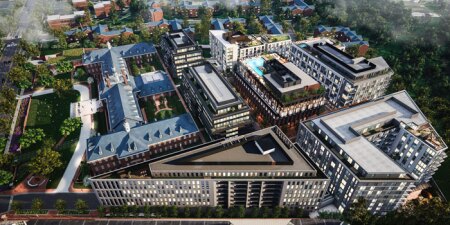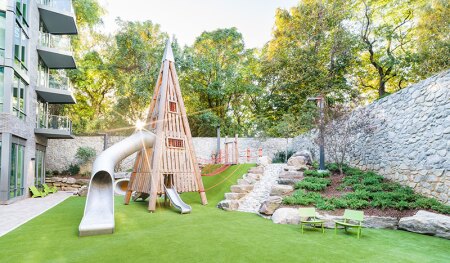It took a big hole in the ground to make a big Washington, D.C., mixed-use redevelopment work.
That hole—an excavation below an existing historic building—was key to configuring space for grocer Wegmans at City Ridge, a $715 million, 1.8 million-square-foot (167,000 sq m) redevelopment of a 10-acre (4 ha) site in the capital’s affluent Northwest quarter, about four miles (6.4 km) from downtown. At buildout later this year, City Ridge will include 160,000 square feet (14,800 sq m) of office space; 154,000 square feet (14,300 sq m) of retail and restaurant space, including Wegmans; and 690 rental apartments, including 56 affordable units, in four buildings. All buildings are certified Leadership in Energy and Environmental Design (LEED) Gold, and the project as a whole is designated LEED v4 for Neighborhood Development Gold.
Without the Wegmans, the city’s first, it would have been more difficult to attract other tenants, says Richard Lake, founding principal of D.C.-based real estate firm Roadside Development. The three ingredients essential to making the project work: “Get Wegmans, get community support, and get enough real estate to justify the rest of the project,” he said during a recent tour of the property.
Construction at City Ridge began in 2018, meaning much of the work took place during the height of the COVID-19 pandemic. So, in addition to the expected challenges of such a large infill project—such as financing, neighborhood concerns, and site surprises—the development team faced supply chain and marketing complications.
Roadside, with capital partner North America Sekisui House LLC (NASH), a subsidiary of a Japanese homebuilder, developed the project; Whiting-Turner is the general contractor; and Shalom Baranes Associates is the project architect.
Mixed Uses in a Suburban Setting
The site previously was the headquarters of mortgage giant Fannie Mae (Federal National Mortgage Association), which occupied a Colonial Williamsburg–inspired main building constructed in 1956 for Equitable Life Insurance Co. That building, now on the National Register of Historic Places, sits behind a deep lawn that separates it from busy Wisconsin Avenue. The surrounding neighborhood includes upscale multifamily buildings, main campuses for American University and the University of the District of Columbia, parks, and block after leafy block of single-family houses selling for well over $1 million.
Fannie Mae, which has been under federal conservatorship since the 2008 financial crisis, put the site on the market in 2015 as part of a cost-saving consolidation of its office space. In addition to the centerpiece 225,000-square-foot (20,900 sq m) red-brick office building, the secure corporate campus had a three-story open-air parking deck, a loading dock, and some smaller structures.
Lake says his firm turned to past collaborators to make its bid. “Our first call when the property became available was to Wegmans,” familiar to Roadside from its previous work with grocery chains. “Having them at the table is so important: they know their business.”
Capital came from NASH, the other development partner, which had worked with Roadside on an earlier project. “Tom McKay [NASH’s chief development officer] called me back in a day,” Lake says. “So, the two lead partners were at the table when we bid.” Deep-pocketed national firms also were eyeing the site. Having capital from NASH, rather than a financing structure reliant on debt, put Roadside on competitive footing with those out-of-town firms, according to the Washington Business Journal. The Journal named the purchase its 2016 real estate deal of the year.
The team closed on the site in 2016, paying $86 million, and leased it back to Fannie Mae for two years while that company waited to move to its new downtown office space.
“The next step was pricing out our thesis: how do you justify that price tag?” Lake says. How do you organize 10 acres in the city, with a grocery tenant that prefers big suburban spaces, and fit it into the fabric of a historic structure?
Minimizing Drama
Keeping the Fannie/Equitable building was always part of the plan, Lake says. The building was a longtime local landmark, but at the start it was not designated as historic. The developers applied for the historic designation, in good part to build community goodwill. “We wanted the community to relax and not be concerned that we would be taking down this iconic building,” Lake says.
Indeed, in a part of the city where residents often fight new development, this project appears to have moved with minimal drama. The proposed development was matter-of-right zoning, but its size and uses triggered the city’s Large Tract Review process. That process solicits opinions from a variety of city agencies and requires identification of potential neighborhood concerns. Most of those involved fears of increased traffic, especially trucks, according to comments filed by the Advisory Neighborhood Commission (ANC), the District’s most granular local government level.
Developers addressed some of those concerns, the ANC wrote as part of the review process, saying it “commends the Applicant for working with the neighborhood to mitigate the impacts of the development, including taking steps to shield the truck entrance and route commercial traffic away from residential streets; for planning green initiatives, including saving large trees, installing green roofs and sending truck traffic underground; and for preserving the lawn area and using it as a community space.”
One complication of preserving the historic building: existing ceiling heights meant there was no way to meet Wegmans’ requirements by simply putting the grocer in the first two floors of the building, the obvious space.
As Lake recalls, the team was batting around ideas when Brian Corcoran, Roadside partner and director of construction and development, said, “Why not just hold the building up and dig out eight feet?”
“And we said, ‘What?’”
After that initial skeptical reaction, the team worked out how to pull the dig off, eventually dropping the foundation 25 feet (7.6 m). The slope of the site—20 feet (6 m) from the Wisconsin Avenue frontage to the far edge—meant that digging out the foundation and regrading produced the ceiling heights Wegmans required. The store would be tucked under the building but still have an aboveground entrance. The regrading also lowered the elevation from which new building heights could be measured, in compliance with D.C.’s height restrictions.
“Immediately we opened up the entire footprint to Wegmans,” Lake says. Overall, the developable floor/area ratio rose from about 850,000 square feet (79,000 sq m) to 1.2 million square feet (111,000 sq m). And that, he says, was “enough meat on the bones to pay for it all.”
The excavation was not simple. Each of the 96 foundation piles of the old building was reinforced with four micro-piles. Robert Wolcheski, Roadside’s project director for City Ridge, recalls that the 12-month dig moved 440,000 cubic yards (336,400 cu m) of dirt, mostly fill, and went down 64 feet (19.5 m) to bedrock. Among the challenges: an underground diesel storage tank that had been leaking for about 14 years, he says.
Construction concrete came from an on-site plant, which saved six months of construction and thousands of trips by concrete trucks, Lake and Wolcheski say, reducing both greenhouse gas emissions and neighborhood disruption.
In late 2019, the developers signed a 22-year lease with their largest office tenant, the International Baccalaureate’s Global Centre for the Americas, which will eventually fill 100,000 square feet (9,300 sq m).
“And then,” Lake says, “COVID hits.”
“Let’s Buy Everything”
In early 2020, as concerns about the virus grew, “We said, let’s buy everything,” Lake recalls. That meant steel, concrete, rebar, PVC pipes, exterior sheeting, and more. Years before the apartment interiors would be built out, developers bought cabinets and appliances, less concerned about storage costs than supply disruptions. NASH agreed to front the money.
As Wolcheski recalls, when much of the economy shut down that spring, workers were still pouring concrete and performing other outdoor labor, so construction disruptions were minimal. But marketing presented other challenges. Travel and face-to-face presentations were out of the question.
Given the size of the project, “renderings don’t do it justice,” he says. Architectural illustration firm Studio 4D, which has offices in Washington and Uruguay, created a virtual replica of the project that became a cloud-based walkthrough.
“That turned into our best leasing tool,” Wolcheski says. Over the next two years, while COVID surged, the team pre-leased all the office space and 97 percent of the retail space, he says. The same walkthrough technology is being used to market the apartments, which are being managed by Bozzuto Group, another local firm.
Those apartments average 928 square feet (86 sq m), larger than those in many other city buildings. Monthly rents range from $2,100 for a 500-square-foot (46 sq m) studio—in line for D.C. luxury buildings—up to $11,000 for a three-bedroom penthouse. Target tenants are empty nesters, high-net-worth individuals looking for a second in-town place, international finance or embassy employees, and even young families.
Lake and Wolcheski emphasize what they see as key to City Ridge’s success fitting into the surrounding city: “When you live here, it’s important you know you live in the broader city,” Lake says.
The expansive lawn in front of the historic building—closed for security reasons while Fannie Mae occupied the site—is now open to the community. Youth orchestras have performed there, and watch parties for the Citi Open tennis tournament were held nearby. The Wegmans opened in July 2022 to lines of enthusiastic shoppers. “For all the excitement, you’d have thought the city was getting a Disneyland,” local online news site DCist wrote.
Among the big lessons he would share with other developers, Lake says: “Don’t be afraid of embracing the community around you. Engage early on. . . . The broader community is your customer’s customer.”
MARYANN HAGGERTY is a Washington, D.C.–based freelance journalist who writes about business, economics, and finance.








